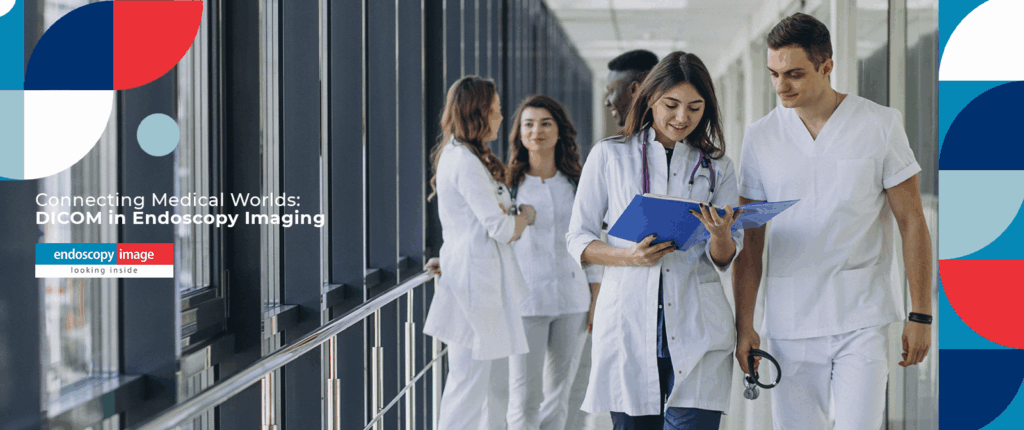Endoscopy Equipment in Mexico and Latin America: Your Complete 2025 Buying Guide
Discover the key differences between endoscopy and colonoscopy procedures. Expert guide for medical..
+1 (786) 681-5247
admin
July 15, 2025

In the intricate world of medical diagnostics, endoscopy professionals face an increasingly complex challenge: managing, storing, and sharing critical patient imaging data with unprecedented efficiency and security. At the heart of this technological revolution lies DICOM (Digital Imaging and Communications in Medicine) – a game-changing standard that has become the backbone of modern medical imaging technology.
This comprehensive guide will demystify DICOM, providing clinic owners and medical professionals with a deep dive into how this technology is transforming diagnostic workflows. From seamless electronic health record integration to advanced imaging management, DICOM represents far more than a technical standard – it’s a gateway to enhanced patient care and operational excellence.
DICOM is a comprehensive communication protocol that has emerged as the global standard for medical imaging. Developed to address the complex needs of medical imaging departments, this standard ensures that medical images and associated information can be shared, stored, and interpreted consistently across different systems and healthcare providers.
Modern endoscopy practices require more than just image capture. DICOM enables a holistic approach to patient data management by providing:
Leading endoscope manufacturers like Olympus, Fujinon, and Pentax now incorporate native DICOM support, enabling:
During an endoscopic procedure, DICOM technology ensures:
DICOM functions as a universal translation layer between medical systems, facilitating:
Successful DICOM integration requires:
Emerging technologies are rapidly expanding DICOM’s capabilities:
➡️ DICOM represents a critical technological standard in medical imaging that serves as a universal language for digital medical images, particularly in endoscopy. Unlike traditional image formats, DICOM goes beyond simple file storage by creating a comprehensive digital ecosystem that ensures medical images can be consistently captured, stored, shared, and interpreted across diverse medical systems. For endoscopy clinics, this means transforming isolated image files into intelligent, metadata-rich documents that carry critical patient information, procedure details, and diagnostic insights. The importance of DICOM lies in its ability to break down technological barriers, enabling seamless communication between different medical devices, software platforms, and healthcare providers.
➡️ In the complex world of medical diagnostics, DICOM acts as a powerful workflow optimization tool for endoscopy clinics. By standardizing image formats and creating a universal communication protocol, DICOM eliminates the traditional challenges of incompatible systems and manual data management. Imagine a scenario where endoscopic images are automatically tagged with patient information, procedure details, and diagnostic notes, then instantly integrated into electronic health records. This automation significantly reduces administrative burden, minimizes human error, and accelerates the entire diagnostic process. Physicians can now access comprehensive patient imaging histories with a few clicks, collaborate more effectively with colleagues, and make more informed clinical decisions. The result is a more efficient, accurate, and patient-centered approach to medical imaging.
➡️ Modern endoscopy equipment from leading manufacturers has increasingly embraced DICOM as a standard protocol. Brands like Olympus, Fujinon, and Pentax have recognized the critical importance of interoperability and have integrated native DICOM support into their latest device generations. This means that contemporary endoscopes are designed from the ground up to capture, process, and transmit images using DICOM standards. The compatibility extends beyond mere image storage, encompassing comprehensive metadata management, seamless integration with hospital information systems, and advanced image processing capabilities. For clinic owners, this translates to a more cohesive technological ecosystem where different devices and software platforms communicate effortlessly, reducing technical complexity and improving overall diagnostic efficiency.
➡️ While implementing DICOM might initially seem like a significant investment, it represents a strategic long-term cost optimization strategy for medical practices. The upfront costs of upgrading systems and training staff are quickly offset by substantial operational efficiencies. By eliminating compatibility issues between different imaging devices and software, clinics can reduce IT support expenses and minimize the risk of costly technological disruptions. DICOM's standardized approach means fewer redundant imaging procedures, more accurate diagnoses, and streamlined administrative processes. Moreover, the enhanced ability to share and collaborate on medical images can reduce the need for repeated examinations, saving both time and resources. From a financial perspective, DICOM is not an expense but an investment in more efficient, accurate, and patient-centered healthcare delivery.
➡️ DICOM was designed with robust security and patient privacy as fundamental principles. The standard incorporates multiple layers of data protection, ensuring that sensitive medical information remains confidential and secure. Each DICOM file includes advanced encryption mechanisms that protect both the image and its associated metadata during transmission and storage. Access control features allow healthcare institutions to implement granular permissions, ensuring that only authorized personnel can view or modify patient records. The system maintains comprehensive audit trails, tracking every interaction with a medical image, which is crucial for maintaining compliance with healthcare regulations like HIPAA. Additionally, DICOM's standardized security protocols mean that data remains protected across different systems and platforms, reducing vulnerabilities that can arise from incompatible security frameworks.
DICOM represents more than a technical standard – it’s a fundamental paradigm shift in medical imaging conception, management, and utilization. For forward-thinking clinic owners and medical professionals, understanding and implementing DICOM is no longer optional; it’s a critical competitive advantage.
Discover the key differences between endoscopy and colonoscopy procedures. Expert guide for medical..
Discover the key differences between endoscopy and colonoscopy procedures. Expert guide for medical..
Discover the main types of scopes used in endoscopy and their purposes. Learn..
Unlock the power of DICOM in endoscopy: Learn how this critical standard revolutionizes..
Deprecated: File Theme without comments.php is deprecated since version 3.0.0 with no alternative available. Please include a comments.php template in your theme. in /home/endoscop/public_html/wp-includes/functions.php on line 6131